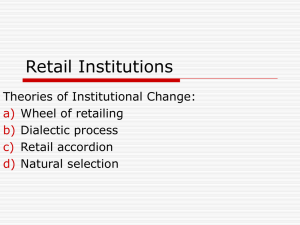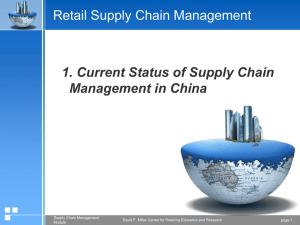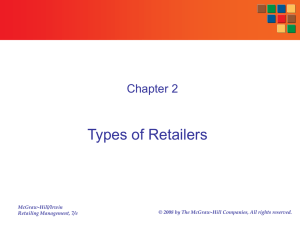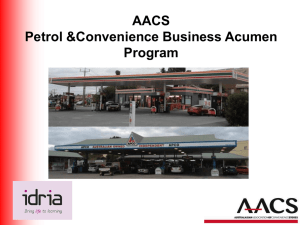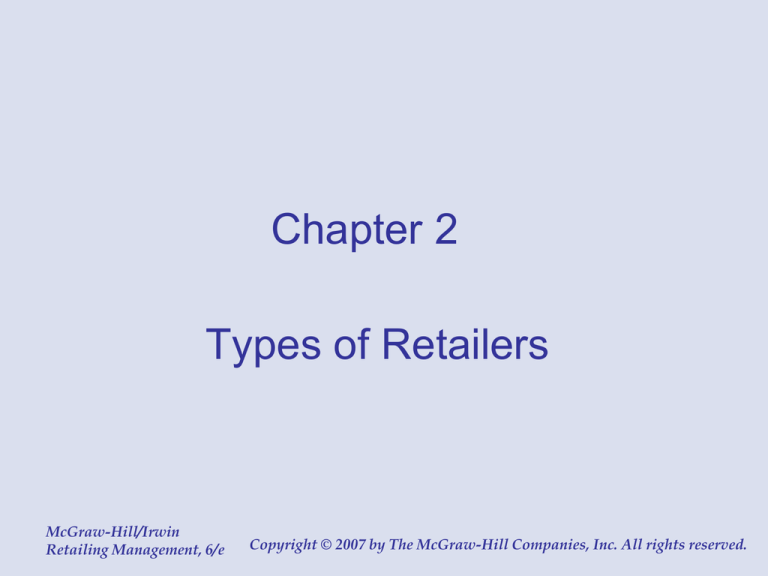
Chapter 2
Types of Retailers
McGraw-Hill/Irwin
Retailing Management, 6/e
Copyright © 2007 by The McGraw-Hill Companies, Inc. All rights reserved.
2--2
The World of Retailing
Increasing Industry
Concentration
Globalization
Growing Diversity
of Formats
2--3
General Trends in Retailing
•
•
•
•
•
New Types of Retailers
Increased Concentration
Globalization
Growth In Services Retailer
Demise of Pure Electronic Retailers (Webvan,
eToys, etc)
• Growth in Use of Multi-Channel Retailing by
Traditional Retailers
• Increase Use of Technology to Reduce Cost,
Increase Value Delivered
2--4
Merchandise Offering
• Variety (breadth of merchandise)
The number of merchandise categories
Jack Star/PhotoLink/Getty Images
C Squared Studios/Getty Images
Stockbyte/Punchstock Images
• Assortment (depth of merchandise)
The number of items in a category (SKUs)
Royalty-Free/CORBIS
Royalty-Free/CORBIS
Royalty-Free/CORBIS
Royalty-Free/CORBIS
2--5
Variety and Assortment of Bicycles
2--6
Types of Retailers
Food Retailers
Mom and Pop Stores
Convenience Stores
Supermarkets
Supercenters
General Merchandise Retailers
Department Stores
Specialty Stores
Discount Stores
Category Specialists
Off-Price Retailers
Warehouse Clubs
2--7
Food Retailers
Primary Shopping Format for Food Sales
Growth Rates by Retail Format
2--8
Globalization of Wal-Mart
2--9
Characteristics of Food Retailers
2--10
Limited Assortment Supermarkets
Save-A-Lot’s limited assortment format
means that stores carry the most
frequently purchased grocery items in
the most popular size and variety
The company carries high quality
exclusive brands – many produced by
the
same manufacturers of leading name
brands – and an assortment of
nationally
branded items.
Used by permission of Save-A-Lot
This allows Save-A-Lot to offer savings
of up to 40% compared to
conventional grocery stores – without
asking shoppers to sacrifice quality.
2--11
Conventional Supermarket Survival Pack
Emphasize Fresh Perishables
Target health conscious and ethnic consumers
Provide a better in-store experience
Offer more private label brands
2--12
Food Retailers
Supermarkets
-Cars, highways and TV to build
brands
-Knowledgeable customers – self
service
-Perishable vs. packaged goods
Big Box Retailers
-Warehouse Clubs
-Supercenters
-Hypermarkets
Convenience Stores
2--13
Convenience Stores Fight Competition
•
•
•
•
•
•
Tailors associates to local market
Stores are more convenient to shop
Offers fresh food
Fast, casual restaurants
Financial services available
Opening smaller stores closer to
consumers – like airports
2--14
Issues in Food Retailing
Competition from Discount Stores
Efficient
Distribution
Lower Costs
Lower Prices
Changing Consumption Patterns
Time Pressure
Eating Out More
Meal Solutions
2--15
Types of General Merchandise Retailers
•
•
•
•
•
•
•
•
Department Stores
Specialty Stores
Category Specialists
Home Improvement Centers
Discount Stores
Drugstores
Off-Price retailers
Extreme Value Retailers
2--16
Characteristics of General Merchandise
Retailers
2--17
Issues in Department Store Retailing
• Competition
-Discount Stores on Price
-Specialty Stores on Service, Depth of
Assortment
• Lower Cost by Reducing Services (?)
-Centralized Cash Wraps
• More Sales (?)
-Customers Wait for Sale
• Focus on Apparel and Soft Home
• Develop Private Labels and Exclusive Brands
2--18
Three Tiers of Department Stores
First Tier: upscale, high fashion chains with
exclusive designer merchandise and excellent
customer service.
Example: Nordstrom, Neiman Marcus,
Bloomingdales, Saks
Second Tier: Retailers sell more modestly
priced merchandise with less customer service:
Example: Macy’s
Third Tier: Value oriented caters to more price
conscious customer
Example: JCPenney, Sears, Kohl’s
Rob Melnychuk/Getty Images
2--19
What To Do With an Eroding Market
To deal with an eroding market Department stores are:
•attempting to increase the amount of exclusive merchandise
they sell
•undertaking marketing campaigns to develop strong images
for their stores and brands
•building better relationships with
their key customers
Royalty-Free/CORBIS
2--20
Issues in Discount Store Retailing
• Only Big Three Left
Wal-Mart, Kmart, Target
• Wal-Mart’s Dominance
• Differentiate Strategy
Wal-Mart = Low Price and Good value
Target = More Fashionable Apparel
• Competition from Category Specialists
Toys-R-Us, Circuit City, Sports Authority
McGraw-Hill Companies,
Inc./Gary He,
photographer
2--21
Issues in Specialty Store Retailing
Mall-Based Apparel Retailers
Decline in Mall Shopping and
Apparel Sales
-Lack of New Fashions
-Less Interest in Fashion
-Increase Price Consciousness
McGraw-Hill Companies, Inc./Gary He, photographer
Lifestyle Formats – Abercrombie
and Fitch and Hot Topics
2--22
Issues in Drug Store Retailing
• Consolidation – Walgreens, CVS,
Rite-Aid
• Competition from Supermarkets,
discount Stores and mail-in orders
• Evolution to a New Format
• -Stand Alone Sites with Drive Thru
Windows
• -offering more frequent purchase
food items
• Improved systems provide
personalized service in the
pharmacy
Keith Brofsky/Getty Images
2--23
Category Specialists
• Deep and Narrow Assortments
Destination Stores
• Low Price and Service
• Wholesaling to Business
Customers and Retailing to
Consumers
• Incredible Growth
Ryan McVay/Getty Images
Issues in Home Improvement
Centers
2--24
Home Depot and Lowes act as both:
Retailer
Consumer
and
Wholesaler
Business
2--25
Home Improvement Centers
Displays are warehoused
Customer Service: How to
select and how to use
merchandise
Competition focuses on
price, effort to differentiate
and services provided
Ryan McVay/Getty Images
2--26
Issues in Extreme Value Retailing
• Focuses on Lower Income Consumers
• Names mostly imply good value not $1 price
points
• Low Cost Location
• Limited Services
• One of the Fastest Growing Retail Segments
Dollar Tree
Dollar General
Family Dollar
99 Cents Only Store
Stockbyte/Punchstock Images
2--27
Non-store Retail Formats
Electronic Retailing
Catalog and Direct Mail
Direct Selling
Television Home Shopping
Vending Machines
Ryan McVay/Getty Images
Royalty-Free/CORBIS
2--28
Electronic Retailing
• History of frenzied investments and
false predictions of retail dominance
• Primarily used by traditional retailers to
compliment store and catalog offerings
• Exclusive e-tailers target small and
dispersed niche markets
Randy Allbritton/Getty Images
2--29
What are Amazon and eBay?
• Amazon.com – Merchandise to consumers.
Provides website development and
fulfillment services to other retailers
• eBay – Acts as a mall or other shopping
center providing a “place” for buyers and
sellers to meet
Don Farrall/Getty Images
2--30
Issues in Catalog Retailing
•
•
•
•
•
•
•
Low Start Up Cost
Evolution of Multi-Channel Offering
Hard to compete with large well established firms
Increasing Mail Costs
Clutter from other Catalogs
General merchandise catalogs like JC Penney
Specialty Catalogs like JC Whitney, Victoria
Secret
2--31
Issues in Direct Selling
• Providing information and demonstrations
is costly
• Party plan system: merchandise is
demonstrated in a party atmosphere
• Multi-level network: Master distributors sell
to distributors who sell merchandise
• Pyramid schemes: Firm sells to other
distributors and little if any merchandise
goes to end users
2--32
Issues in Television Home Shopping
• Consumers watch cable stations, infomercials or
direct response ads
• Few consumers watch regularly
• Most purchases made by small proportion of
viewers
• Customers can’t examine merchandise
• Customers must wait for merchandise to come
on
• Sells mostly jewelry, apparel, cosmetics,
kitchenware, exercise equipment
Royalty-Free/CORBIS
2--33
Issues in Vending Machine Retailing
• Sales growth has been
declining due to higher
prices and healthier eating
habits
• New technology may help
sales growth
• Vending machines are
beginning to accept credit
• Trend of placing machines in
captive consumer locations
Ryan McVay/Getty Images
2--34
Types of Nonstore Retailers
2--35
Sales by Catalog Retailers
2--36
Services vs. Merchandise Retailers
Intangibility
-Problems in Evaluating Service Quality
-Performance of Service Provider
Simultaneous Production and Delivery
-Importance of Service Provider
Perishability
-No Inventory, Must Fill Capacity
Inconsistency of the Offering
-Importance of HR Management
2--37
Examples of Service Retailers
Type of Service
Service Retail Firms
Airlines
American, Delta, British Airways, Singapore Airways
Automobile maint/repair
Jiffy Lube, Midas, AAMCO
Automobile rental
Hertz, Avis, Budget, Alamo
Banks
Citibank, NCNB, Bank of America
Child care centers
Kindercare, Gymboree
Credit cards
American Express, VISA, Mastercard
Education
University of Florida, Babson College
Entertainment parks
Disney, Universal Studios, Six Flags
Express package delivery Federal Express, UPS, US Postal Service
Financial services
Merrill Lynch, Dean Witter
Fitness
Jazzercise, Bally’s, Gold’s Gym
Health Care
Humana, HCA
Home maintenance
Chemlawn, MiniMaid, Roto-Rooter
2--38
Examples of Service Retailers
Type of Service
Service Retail Firms
Hotels and motels
Hyatt, Sheraton, Marriott, Days Inn
Income tax preparation
H & R Block
Insurance
Allstate, State Farm
Internet access/Elec info.
American On-Line, CompuServe
Movie theaters
AMC, Loews/Sony, Universal
Real estate
Century 21, Coldwell Banker
Restaurants
TGI Friday’s, Wendy’s, Pizza Hut
Truck rentals
U-Haul, Ryder
Weight loss
Weight Watchers, Jenny Craig
Video rental
Blockbuster, Hollywood Video
Vision centers
Lenscrafter, Pearle
2--39
Merchandise/Service Continuum
2--40
Types of Retail Ownership
• Independent, Single Store Establishments
Wholesaler Owned Cooperatives
• Corporate Chains
• Franchises
(c) Brand X Pictures/PunchStock
2--41
Retailers Using Franchise Business Model
2--42
Franchising
30 – 40% of US Retail Sales
Franchisee Pays Fixed Fee
Plus % of Sales
Franchisee Implements
Program
Why is This Ownership Format
Efficient?
The McGraw-Hill Companies, Inc./Jill Braaten, photographer
2--43
Reasons for Franchising Failure
Inept management
Fraudulent activities
Market saturation
2--44
Franchising Trends for the New Millenium
Sustained growth
Enduring plus un-imagined applications
International expansion
Increasing tensions
Greater emphasis on financial returns
2--45
Which Types of Retailers Will Be the
First to Pursue Global Markets?
Discount Stores
Category Specialists
Department Stores
Supermarkets
Services Retailers
2--46
Increasing Concentration
53% of sales
85% of sales
Drug Stores
Walgreens, CVS, Rite-Aid and Eckerds
Discount Stores
Wal-Mart, Target and Kmart
Why Is the Retail Industry
Becoming More Concentrated?
Traditionally retailers have been local
businesses.
• Why are bigger firms emerging?
• Why are least concentrated sectors food
retailers and services retailers?
2--47

